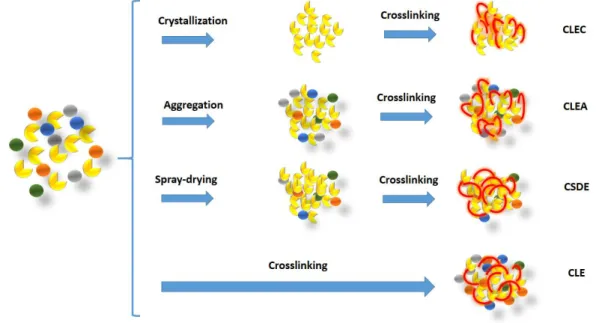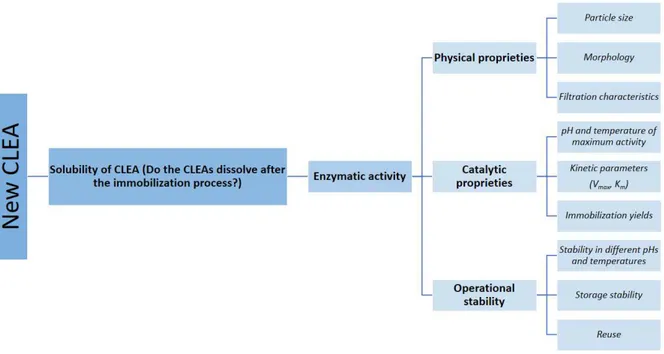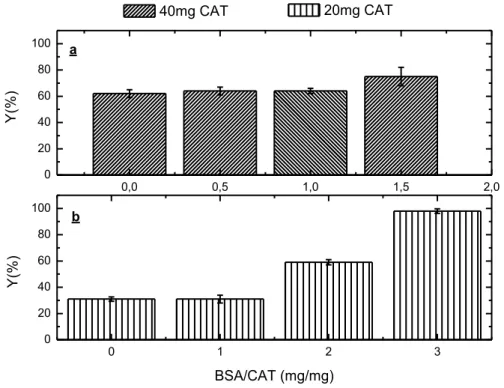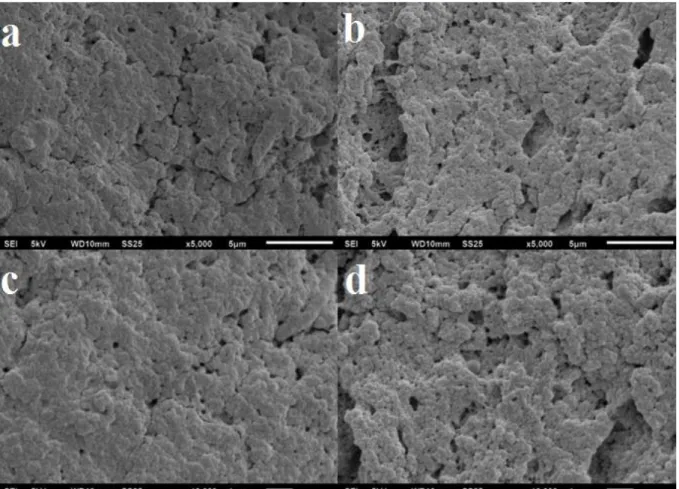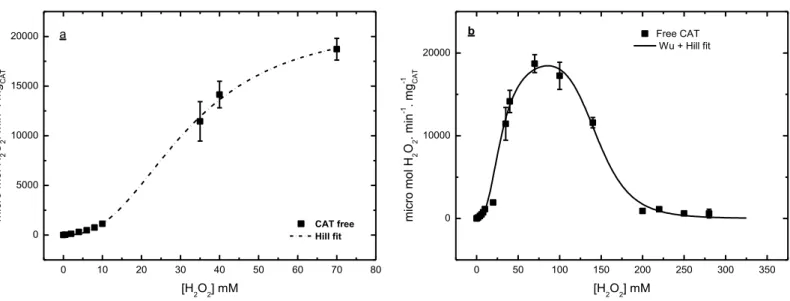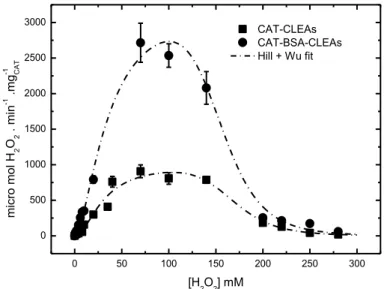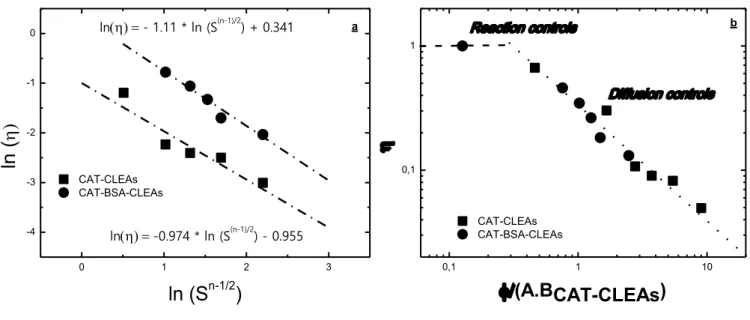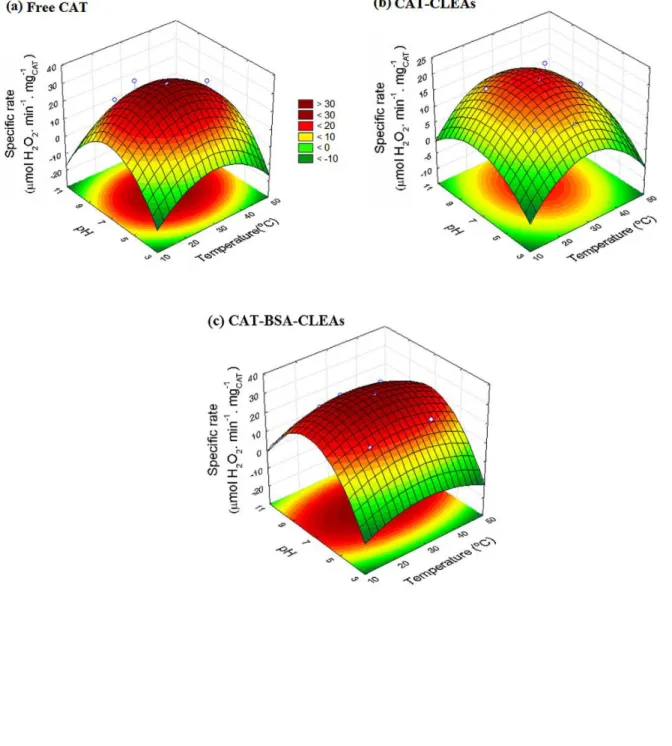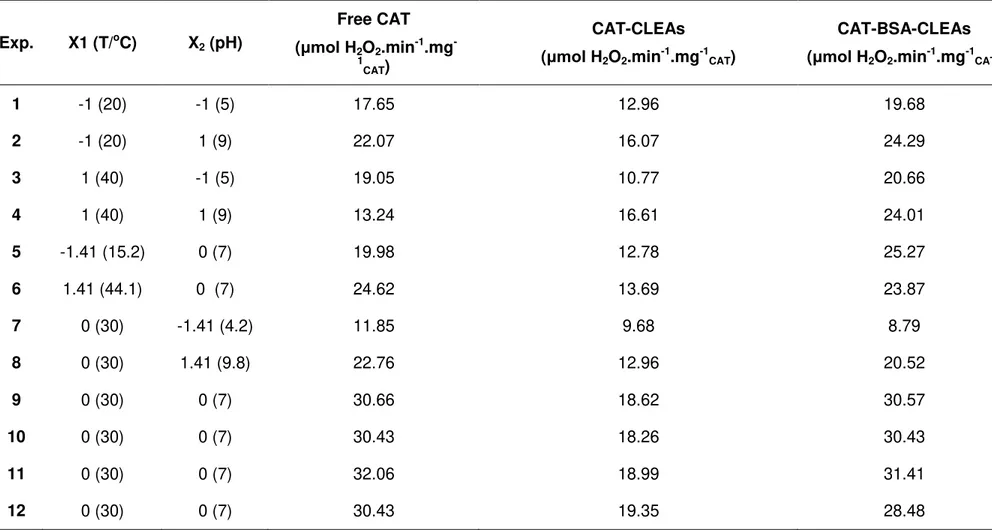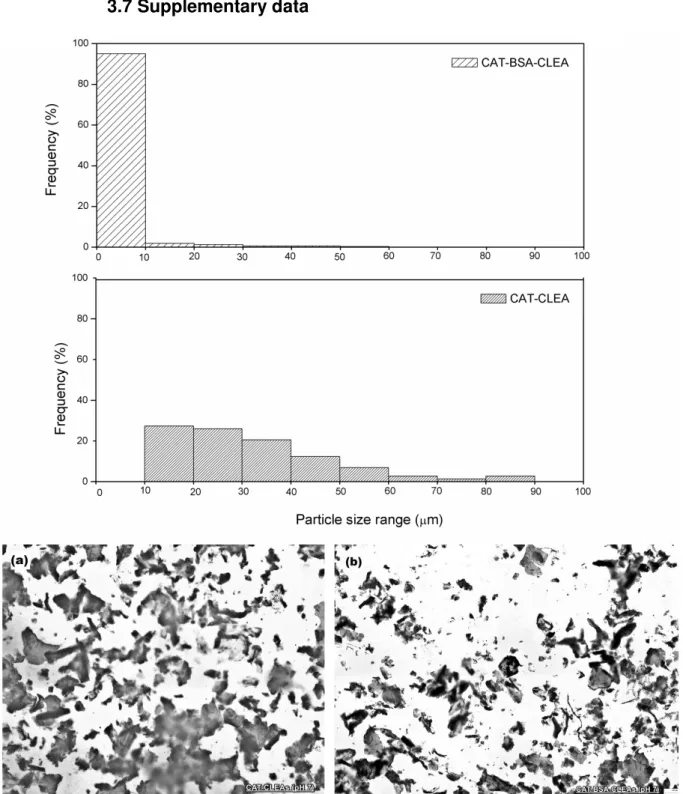PROGRAMA DE PÓS-GRADUAÇÃO EM ENGENHARIA QUÍMICA
BIOCATALYST ENGINEERING APPLIED TO THE IMPROVEMENT OF CROSS-LINKED ENZYME AGGREGATES AIMING AT THE MULTIENZYMATIC CONVERSION OF SUCROSE TO GLUCONIC ACID AND FRUCTOSE SYRUP
Agnes Cristina Oliveira Mafra
PROGRAMA DE PÓS-GRADUAÇÃO EM ENGENHARIA QUÍMICA
ENGENHARIA DE BIOCATALISADORES APLICADA À SÍNTESE DE CLEAS PARA A APLICAÇÃO NA CONVERSÃO MULTIENZIMÁTICA DE SACAROSE À
ÁCIDO GLUCÔNICO E XAROPE DE FRUTOSE
Agnes Cristina Oliveira Mafra
CENTRO DE CIÊNCIAS EXATAS E DE TECNOLOGIA PROGRAMA DE PÓS-GRADUAÇÃO EM ENGENHARIA QUÍMICA
BIOCATALYST ENGINEERING APPLIED TO THE IMPROVEMENT OF CROSS-LINKED ENZYME AGGREGATES AIMING AT THE MULTIENZYMATIC CONVERSION OF SUCROSE TO GLUCONIC ACID AND FRUCTOSE SYRUP
Agnes Cristina Oliveira Mafra
Thesis submitted to Graduate Program in Chemical Engineering of Federal University of São Carlos in partial fulfillment of requirements for the Degree of Doctor of Philosophy in Chemical Engineering, area of concentration in Chemical Process Research and Development.
Supervisor: Prof. Dr. Paulo Waldir Tardioli
Co-supervisor: Prof. Dr. Marcelo Perencin de Arruda Ribeiro
To my advisors Professor Dr. Paulo Waldir Tardioli and Professor Dr.
Marcelo Perencin da Silva, for his dedication, teachings and opportunity to my
personal and professional growth.
To all the Chemical Engineering Department Professors, important
people in my scientific and academic qualification. In particular, to Professor Dr. Ruy
de Sousa Júnior who kindly took part in the Monitoring and Qualifying Examination
Board; and therefore could give suggestions of great value to the paper progress.
Professor Raquel de Lima Camargo Giordano who was part of the Qualifying
Examination Board. Doctor William Kopp who was part of the Monitoring Examination
Board, and that for many years has divided knowledge and laboratory bench with me,
thank you! Professor Monica Lopes Aguiar from the Laboratory of Environmental
Control (DEQ/UFSCar) by the microscopy images of CLEAs. Professor Alberto Colli
Badino from Laboratory of Fermentation (DEQ/UFSCar) by pneumatic reactors and
oxygen measuring equipment used in this study. I thank the Embrapa
Instrumentation (São Carlos, SP, Brazil) for granting use of SEM equipment.
To the staff because of their prompt help and patience, in particular the
technician Amadeus.
I thank the scientific initiation students Maisa Beltrame and Letícia
Ulrich who collaborated in experimental practices of this thesis and so that I could
progress as a Professor.
The study herein was supported by the following Brazilian Foundations:
SPECIAL AKNOWLEDGEMENTS
First of all, I am grateful to God for the unconditional care throughout my life and especially during the four years of doctoral programs.
I would like to thank the friends from the Enzymatic Technology Laboratory: Felipe Silva, Laiane Antunes, Thaís Milessi e Paula Novelli; and the friends from Fermentation Laboratory: Mateus, Diego, Nayana, Kaio, Carol, Jorge e Paula Carvalho, for friendship, conversation and support during the study. I thank my great high school friends Keila Zeni and Eduardo Mandu, for friendship, support and consideration!! To “café com bobagem” friends. Ricardo, Andreza, Guilhermina, Duda, Gabriel, Erich, Felipe, Mateus, Paula Rosa, Anderson.
I am grateful to the love of my life, William, for encouragement, emotional and financial support. For all our years of partnership, for having been strong at the defense final stretch cheerful and patiently!! I love you dear!
To all my relatives for love and encouragement which made me courageous to face all challenges until the conclusion of this paper. A special thanks to my parents, Jô e Aguinaldo, who with great love supported me emotionally and financially during all years of study.
“Life is not easy for any of us. But what of that? We must have perseverance and
above all confidence in ourselves. We must believe that we are gifted for something
Sugarcane sugar (sucrose) is a raw material produced in abundance in Brazil; it is very attractive to produce high added-value products. Gluconic acid (GA) can be obtained by multienzymatic conversion of sucrose, using three enzymes. Firstly, invertase (INV), responsible for the inversion of sucrose into glucose and fructose, next glucose oxidase (GOD) for the glucose oxidation and the last enzyme is
catalase (CAT) used for the decomposition of hydrogen peroxide (H2O2, by-product
from glucose oxidation). In this study, the sucrose was inverted in a fed-batch process catalyzed by INV immobilized as cross-linked enzyme aggregate (CLEA). The GA was produced by glucose oxidation catalyzed by combinate CLEAs
(Combi-CLEAs) of CAT from bovine liver and GOD from Aspergillus niger in a batch
pneumatic reactor. CAT has a tetrameric structure which complicates its stabilization through conventional immobilization technique. CLEAs of CAT were prepared, evaluating the effect of precipitant and cross-linking agents, as well as bovine serum albumin (BSA) as feeder protein on the catalytic properties, thermal stability, and mass transport resistance of the derivatives. The most active derivatives were prepared using ammonium sulfate as precipitant agent, 50 mM glutaraldehyde as cross-linker, and BSA/CAT mass ratio of 3.0. These derivatives were almost
completely active (yield of immobilization up to 100%) and highly stable at 40 oC and
pH 7.0 (~ 80% of the initial activity was recovery after 200 h under these conditions). The co-precipitation of BSA together with CAT reduced the size of clusters suggesting a decrease of diffusive effects within the biocatalyst. Empirical kinetic model was fitted to the experimental data of initial rate vs. substrate concentration and used to make a comparative analysis of mass transfer into derivatives with and without BSA. Results suggested that the main effect that differentiates the free enzyme and the two derivatives analyzed was of diffusive nature. In fact, the effectiveness factor of the crosslinked aggregates of catalase with BSA increased approximately 4 times. The statistical experimental design and the analysis of the response surface methodology showed that the immobilization did not alter the
conditions of maximum activity of the CAT, which were found to be 30 oC and pH
hydrolysis of sucrose at 40 C and pH 6.0, maintaining the reaction conversion above 75 %. The hydrolysis of sucrose catalyzed by immobilized INV showed to be economically feasible in an operational window built based on economic metrics for a fed-batch process with three intermittent sucrose feeds to restore the substrate
concentration at 100 g.L-1 when the conversion reaches 95 %. This work represents
an advance in the field, because using a carrier-free and recyclable biocatalyst the specific productivity (gram of products per gram of biocatalyst per hour) of inverted sugar syrup was as high as those previously reported for INV immobilized on solid carriers that may dilute its volumetric activity and increase the cost of the biocatalyst. Combi-CLEAs of CAT and GOD were prepared, evaluating the influence of precipitant and cross-linking agents, as well as BSA as feeder protein on enzyme immobilization yield and thermal stability of each enzyme. Combi-CLEAs were prepared using dimethoxyethane as precipitant, 25 mM glutaraldehyde and mass ratio BSA/enzymes of 5.45 (w/w) were selected, their activities and stabilities at 40
oC, pH 6 and 250 rpm for five hours were evaluated. The selected Combi-CLEAs
were used in GA production in a pneumatic reactor with 26 g.L-1 glucose at 40 oC, pH
6 and 10 vvm. Results showed conversion of 100 % and kinetic profile very similar to the free enzymes process. The reusability of Combi-CLEAs was also studied in ten batch-cycles of 5 hours. Operational half-life was calculated from kinetic profiles and first order inactivation model and presented a value of 31.50 hours. Combi-CLEAs of GOD and CAT showed to be relevant robust biocatalyst for GA application and production of glucose.
O açúcar de cana-de-açúcar (sacarose) é uma matéria-prima produzida em abundância no Brasil, sendo muito atraente para produzir produtos com alto valor agregado. O ácido glucônico (AG) pode ser obtido por conversão multienzimática de sacarose, utilizando três enzimas. Na primeira etapa a enzima invertase (INV) faz inversão da sacarose em glicose e frutose, na segunda etapa a enzima
glicose-oxidase (GOD) oxida a glicose formando AG e peróxido de hidrogênio (H2O2) e na
última etapa a enzima catalase (CAT) decompõem H2O2. Neste estudo, a sacarose
foi invertida num processo de batelada alimentada catalisado por agregados reticulados(CLEA) de INV. AG foi produzido por oxidação de glicose catalisada por
CLEAs combinados (Combi-CLEAs) de CAT de fígado bovino e GOD de Aspergillus
niger em reator pneumático operado em batelada. A CAT apresenta uma estrutura
tetramérica que dificulta a sua estabilização através da técnica convencional de imobilização. Assim, prepararam-se CLEAs de CAT separadamente, avaliando a influência de agentes precipitantes e intercruzantes, bem como albumina de soro bovino (BSA) como proteína de alimentação sobre as propriedades catalíticas, estabilidade térmica e resistência ao transporte de massa dos derivados. Os derivados mais ativos foram preparados utilizando sulfato de amônia como agente precipitante, glutaraldeído 50 mM como agente de entrecruzamento e proporção de massa BSA/CAT de 3,0. Estes derivados foram quase totalmente ativos (rendimento de imobilização até 100 %) e altamente estáveis à 40 °C e pH 7,0 (~ 80% da atividade inicial foi recuperação após 200 h nestas condições). A co-precipitação de BSA em conjunto com CAT reduziu o tamanho dos clusters, sugerindo uma diminuição dos efeitos difusivos dentro do biocatalisador. Um modelo cinético
empírico foi ajustado aos dados experimentais de velocidades iniciais vs.
uma alternativa à BSA, comumente usada. A INV imobilizada reteve cerca de 30 % da atividade inicial após ensaio de lixiviação enzimática. A INV imobilizada pôde ser
reciclada em dez ensaios (bateladas de 4 h) de hidrólise de sacarose a 40 oC e pH
6,0, mantendo a conversão da reação acima de 75 %. A hidrólise de sacarose catalisada por INV imobilizada mostrou ser economicamente viável numa janela operacional construída com base em métricas econômicas para um processo de batelada alimentada com três alimentações de sacarose na concentração de
substrato a 100 g.L-1 quando a conversão atingia 95 % . Este trabalho representa um
avanço nesta área, pois utilizando um biocatalisador isento de suporte e reciclável; a produtividade específica (grama de produto por grama de biocatalisador por hora) de xarope de açúcar invertido foi a mais elevada já reportada pela literatura. Prepararam-se Combi-CLEAs de CAT e GOD, avaliando a influência de agentes precipitantes e intercruzantes, bem como BSA como proteína espaçadora sobre o rendimento de imobilização enzimática e estabilidade térmica de cada enzima. Selecionaram-se os Combi-CLEA preparados utilizando dimetoxietano como precipitante, glutaraldeído 25 mM e razão de massa BSA / enzimas de 5,45 (m/m),
avaliando as suas atividades e estabilidades a 40 oC, pH 6 e 250 rpm durante cinco
horas. Os Combi-CLEAs selecionados foram utilizados na produção de AG num reator pneumático a partir de 26 g.L-1 de glucose a 40 oC, pH 6 e 10 vvm. Os
resultados mostraram conversão de 100% e perfil cinético muito semelhante ao processo de enzimas livres. A reutilização de Combi-CLEAs foi também estudada em 10 ciclos reacionais de 5 horas. A meia-vida operacional foi calculada a partir dos perfis cinéticos e do modelo de inativação de primeira ordem e apresentou valor de 31,50 horas. Este trabalho pode concluir que os Combi-CLEAs de GOD e CAT são biocatalisadores relevantes e robustos para aplicação na produção de GA a partir de glicose.
FIGURE 2.1 – METHODS OF ENZYMATIC IMMOBILIZATION: (A) ENTRAPMENT WITHIN POROUS MATRICES,(B) ENCAPSULATION,(C) COVALENT BINDING AND (D) CROSS-LINKING. ... 12
FIGURE 2.2–ENZYME’S CROSSLINKING IN THE ABSENCE OF SUPPORT. ... 15
FIGURE 2.3 –REPRESENTATION OF CROSS-LINKED ENZYME AGGREGATES PREPARATION.IN THE FIRST STEP THE SOLUBLE ENZYME IS AGGREGATED BY THE ACTION OF A PRECIPITATING
AGENT.IN THE SECOND STEP THE CROSSLINKING OF THE ENZYMATIC AGGREGATES OCCURS
BY THE ACTION OF A CROSSLINKING AGENT. ... 16
FIGURE 2.4–PROTOCOL FOR THE CHARACTERIZATION OF NEW CLEAS. ... 19
FIGURE 3.1 – (WHITE COLUMN)OVERALL YIELD OF IMMOBILIZATION OF CAT-CLEAS PREPARED WITH DIFFERENT PRECIPITANT AGENTS: AMMONIUM SULFATE SOLUTION (AS), TERT-BUTYL
ALCOHOL (TBA), POLYETHYLENE GLYCOL (PEG), DIMETHOXYMETHANE (DME), ACETONE
(A), AND GLUTARALDEHYDE CONCENTRATIONS AT 0(A),25 MM(B),50 MM(C),100 MM(D),
AND 200 MM(E).(BLACK COLUMN) ACTIVITY RETAINED BY CAT-CLEAS AFTER 200 H AT 40
OC,
PH7(100 MM SODIUM PHOSPHATE BUFFER). ... 44
FIGURE 3.2 – IMMOBILIZATION OF CAT APPLYING (A) 40 MG (CAT) AND (B) 20 MG (CAT) OF ENZYMATIC PROTEIN AND USING 0, 20, 40 AND 60 MG OF BSA AS A FEEDER PROTEIN.
RESIDUAL ACTIVITY (40OC, PH7,200 H) WAS ~80% FOR ALL BIOCATALYSTS. ... 47
FIGURE 3.3–SEM IMAGES OF CAT-BSA-CLEAS (A, C) AND CAT-CLEAS (B, D). ... 49
FIGURE 3.4 – EFFECT OF H2O2 CONCENTRATION ON THE ACTIVITIES AT 25 OC AND PH 7.5 OF SOLUBLE CAT:(A) THE HILL MODEL FITTED TO EXPERIMENTAL DATA IN THE RANGE WITHOUT
INHIBITION (KCAT = 21,537±799 ΜMOL H2O2.MIN -1.
MG-1CAT, KM = 32.08±1.24 MM AND N =
2.47±0.19). (B) THE MIX HILL AND WU MODELS FITTED TO EXPERIMENTAL DATA IN THE
RANGE WITH AND WITHOUT INHIBITION (KCAT = 19,971±928 ΜMOL H2O2.MIN -1.
MG-1CAT, KI =
IMMOBILIZED CAT.MIX HILL AND WU MODELS FITTED TO EXPERIMENTAL DATA IN THE RANGE
WITH INHIBITION OF CAT-CLEAS (KCAT = 1,000±150 ΜMOL H2O2.MIN -1.
MG-1CAT, KI =
61.1±16.1 MM, KM= 30.5±6.8 MM, N = 1.9±0.5 AND W = 9.6±2.6) AND CAT-BSA-CLEAS
(KCAT= 3,305±387ΜMOL H2O2.MIN -1.
MG-1CAT,KI = 60.9±8.0 MM, KM = 35.12±6.7 MM, N =
1.68±0.25 AND W =9.25±1.30). ... 51
FIGURE 3.6–EFFECTIVENESS FACTORS (Η) FOR IMMOBILIZED CAT(CAT-CLEAS AND
CAT-BSA-CLEAS) WITH N ORDER INTRINSIC KINETIC (N = 2.47) VERSUS (A) LN(√S(N-1)), AND; (B) Φ/ABCAT-CLEAS. ... 55
FIGURE 3.7 – SURFACE RESPONSE SHOWING THE PH AND TEMPERATURE EFFECT ON (A) FREE
CAT,(B)CAT-CLEAS AND (C)CAT-BSA-CLEAS ACTIVITIES. ... 58
FIGURE 4.1–YIELD OF IMMOBILIZATION AFTER THE LEACHING ASSAY (YAFTER LEACHING ASSAY), AT 30OC
PH7.0 FOR 4 H SHAKING AT 250RPM, FOR DERIVATIVES OF INVERTASE (INV) PREPARED BY
THE CLEA TECHNIQUE AS FUNCTION OF THE RATIO GLUTARALDEHYDE CONCENTRATION
(GLU)-TO-AMOUNT OF PROTEIN (INV AND SOY PROTEIN). ... 82
FIGURE 4.2 – SURFACE RESPONSE SHOWING THE PH AND TEMPERATURE EFFECT ON THE ACTIVITIES OF (A) SOLUBLE INVERTASE (INV) AND (B) CLEAS OF INVERTASE
(INV-SOY-CLEAS). ... 85
FIGURE 4.3–EFFECT OF SUCROSE CONCENTRATION ON THE INITIAL ACTIVITIES OF INVERTASE AT
40°C AND PH 6.0. SOLUBLE INVERTASE, INV: (A) MICHAELIS-MENTEN MODEL FITTED TO
EXPERIMENTAL DATA IN THE RANGE WITHOUT INHIBITION; (B) MICHAELIS-MENTEN WITH
SUBSTRATE INHIBITION FITTED IN THE RANGE WITH AND WITHOUT INHIBITION. CLEAS OF
INVERTASE (INV-SOY-CLEA): (C) MICHAELIS-MENTEN MODEL FITTED IN THE RANGE
WITHOUT INHIBITION;(D)WU MODEL FITTED IN THE RANGE WITH AND WITHOUT INHIBITION. . 86
FIGURE 4.4–HYDROLYSIS OF SUCROSE (50 G.L-1) CATALYZED BY INV-SOY-CLEA AT 40°C AND PH 6.0 IN A BATCH REACTOR STIRRED AT 300 RPM. (A) TIME-CONVERSION PROFILES; (B)
6.0. THE CURVES REPRESENT THE MICHAELIS-MENTEN MODEL FITTED TO THE
EXPERIMENTAL DATA (KM=145±18 MM AND KCAT=1.7±0.11·X 103 S-1) COMBINED TO THE
FIRST ORDER EQUATION OF ENZYME INACTIVATION (K =0.016 H-1). ... 93
FIGURE 4.6–(A)SIMULATION OF REUSE OF INV-SOY-CLEA(R1 TO R11) IN THE HYDROLYSIS OF
100 G.L-1 SUCROSE SOLUTION IN A BATCH REACTOR. (B) FEASIBILITY WINDOW USING
THRESHOLD VALUES FOR PROCESS METRICS AND THE DATA ESTIMATED FROM THE FITTED
MODELS.(C)FEASIBILITY WINDOW USING THRESHOLD VALUES FOR PROCESS METRICS AND
THE DATA ESTIMATED FROM THE FITTED MODELS FOR A FED BATCH REACTOR, IN THE
HYDROLYSIS OF 100 G.L-1 SUCROSE SOLUTION, FED OF 40 G OF SUCROSE WHEN
CONVERSION REACH 95%. (D) VALIDATION OF FEASIBILITY WINDOW ESTIMATED FROM THE
FITTED MODELS FOR A FED BATCH REACTOR.[P] IS THE PRODUCT CONCENTRATION IN GPRODUCT
LREACTOR-1;YBIOCATALYST IS THE BIOCATALYST YIELD IN GPRODUCT G BIOCATALYST-1;STY IS SPACE-TIME
YIELD IN GPRODUCTLREACTOR-1 H-1;P IS THE MASS OF PRODUCT IN GPRODUCT. ... 95
FIGURE 5.1–(WHITE)IMMOBILIZATION YIELD OF GOD(A) AND CAT(B) IN THE COMBI-CLEAS IN THE PRESENCE AND ABSENCE OF BSA AS FEEDER PROTEIN. (BLACK)RESIDUAL ACTIVITIES
OF THE GOD IN THE COMBI-CLEAS AFTER 5H AT 40OC AND PH6.0. ... 124
FIGURE 5.2 – GLUCONIC ACID PRODUCTION FROM 26 G.L-1 GLUCOSE SOLUTION CATALYZED BY
THE COMBI-CLEAS GOD/CAT IN A PNEUMATIC REACTOR KEPT AT CONSTANT 40OC AND PH
6.0.(A) TIME-CONVERSION PROFILES;(B) CONVERSIONS AFTER EACH 5 H-BATCH FOR THE
REUSE ASSAYS. ... 126
FIGURE 5.3–EXPERIMENTAL DATA OF REUSE OF COMBI-CLEAS GOD/CAT(R1 TO R10) IN THE GLUCONIC ACID PRODUCTION FROM GLUCOSE IN A BATCH REACTOR KEPT AT 40OC AND PH
6.0.THE CURVES REPRESENT THE MICHAELIS-MENTEN INTEGRATED MODEL FITTED TO THE
EXPERIMENTAL DATA OF FREE GOD/CAT (KM,APP =51.11 ±13.44 MM AND KCAT,APP=1.16·±
LIST OF TABLES
TABLE 2.1–APPLICATION OF IMMOBILIZATION BY CLEAS IN VARIOUS ENZYMES ... 17
TABLE 3.1 – EXPERIMENTAL CONDITIONS AND RESULTS OF THE STATISTICAL EXPERIMENTAL DESIGN FOR FREE CAT,CAT-CLEAS, AND CAT-BSA-CLEAS ACTIVITIES. ... 59
TABLE 4.1 – EXPERIMENTAL CONDITIONS AND RESULTS OF THE STATISTICAL EXPERIMENTAL DESIGN FOR THE INFLUENCE OF PH AND TEMPERATURE ON THE ACTIVITY OF SOLUBLE AND
IMMOBILIZED INVERTASE CROSS-LINKED WITH SOY PROTEIN (INV-SOY-CLEAS). ... 84
TABLE 4.2– COEFFICIENT VALUES AND STATISTICAL ANALYSIS FOR THE ACTIVITIES OF SOLUBLE INVERTASE (INV) AND IMMOBILIZED INVERTASE CROSS-LINKED WITH SOY PROTEIN
(INV-SOY-CLEAS). ... 84
TABLE 4.3– COEFFICIENT VALUES AND STATISTICAL ANALYSIS FOR THE ACTIVITIES OF SOLUBLE INVERTASE (INV) AND IMMOBILIZED INVERTASE CROSS-LINKED WITH SOY PROTEIN
(INV-SOY-CLEAS), AFTER ELIMINATION OF NON-SIGNIFICANT PARAMETERS. ... 85
TABLE 4.4–KINETIC PARAMETERS ESTIMATED FOR THE SUCROSE HYDROLYSIS AT 40OC AND PH
6.0 CATALYZED BY SOLUBLE INVERTASE (INV) AND CLEAS OF INVERTASE
(INV-SOY-CLEAS). ... 87
TABLE 4.5 – PRODUCTIVITY OF INVERTED SUGAR AND OPERATIONAL STABILITY OF IMMOBILIZED INVERTASES ON SOLID CARRIERS AND CLEAS OF INVERTASE. ... 91
TABLE 5.1 – EFFECT OF THE PRECIPITANT AGENT ON THE ACTIVITIES OF GOD (GLUCOSE -OXIDASE) AND CAT(CATALASE) AFTER PRECIPITATE RE-SUSPENSION. ... 121
TABLE 5.2 – PRODUCTIVITY OF GLUCONIC ACID CATALYZED BY GOD/CAT IMMOBILIZED BY DIFFERENT METHODS. ... 127
CONTENTS
1. INTRODUCTION 5
1.1 Gluconic acid 5
1.2 Fructose syrup 6
1.3 Immobilized multienzyme system 7
1.4 Scope of the work and specific research goals 8
1.5 Thesis outline 9
2. IMMOBILIZATION OF ENZYMES AS CROSS-LINKED ENZYME AGGREGATES: REVIEW 12
2.1 Introduction 12
2.2 Carrier-free immobilized enzymes 14
2.3 CLEAs 15
2.4 CLEAs performance evaluation 19
2.5 Feeder protein 21
2.6 Cascade process and Combi-CLEAs 21
2.7 Final considerations 22
2.8 References 23
3. DIFFUSION EFFECTS OF BOVINE SERUM ALBUMIN ON CROSS-LINKED AGGREGATES
OF CATALASE 31
3.1 Introduction 36
3.2 Material and methods 39
3.2.1 Material 39
3.2.2 Methods 39
3.2.2.1 CAT activity assay 39
3.2.2.2 Protein concentration 40
3.2.2.3 Preparation of CAT-CLEAs and CAT-BSA-CLEAs 40
3.2.2.4 Thermo stability study 41
3.2.2.5 Kinetic analysis 42
3.2.2.6 Influence of pH and temperature 43
3.2.2.7 SEM 43
3.3 Results and discussion 44
3.3.1 Preparation CAT-CLEAs 44
3.3.2 Effect of BSA as a feeder protein 46
3.3.3 CAT empiric kinetic 50
3.3.4 Diffusional effects in CAT-CLEAs and CAT-BSA-CLEAs 52
3.3.5 pH and temperature effects on enzymatic activity 56
3.4 Conclusions 60
3.7 Supplementary data
4. ENZYMATIC PRODUCTION OF INVERTED SUGAR USING SOY-CLEAS OF INVERTASE 67
4.1 Introduction 71
4.2 Material and methods 73
4.2.1 Material 73
4.2.2 Methods 73
4.2.2.1 Preparation of INV-CLEAs and INV-SOY-CLEAs 73
4.2.2.2 Biocatalyst evaluation after leaching 74
4.2.2.3 Thermostability study 75
4.2.2.4 pH- and temperature-activity profiles 75
4.2.2.5 Kinetic analysis 76
4.2.2.6 Inverted sugar production 77
4.2.2.7 Operational stability 77
4.2.2.8 Operational feasibility of sucrose hydrolysis 78
4.2.2.9 Validation of operational feasibility of sucrose hydrolysis 79
4.2.2.9 INV activity assay 79
4.2.2.10 Protein concentration 79
4.2.2.11 Chromatographic methods 80
4.3 Results and discussion 80
4.3.1 Screening of parameters for immobilizing invertase by CLEA technique 80
4.3.2 Effect of crosslinker and feeder protein concentration 81
4.3.3 Effects of pH and temperature on the enzymatic activity 83
4.3.3 Kinetic parameters 85
4.3.4 Production of inverted sugar syrup and operational stability 88
4.3.5 Economic assessment and validation 93
4.4 Conclusions 95
4.5 Acknowledgements 96
4.6 Reference 97
4.7 Supplementary data 104
5. COMBI-CLEAS OF GLUCOSE-OXIDASE AND CATALASE FOR MULTICONVERSION OF GLUCOSE TO GLUCONIC ACID PROCESS IN A PNEUMATIC REACTOR 109
5.1 Introduction 113
5.2 Material and methods 115
5.2.1 Material 115
5.2.2 Methods 116
5.2.2.1 GOD and CAT activity assays 116
5.2.2.2 Protein concentration 117
5.2.2.3 Combi-CLEA preparation 117
5.2.2.3.1 Selection of the precipitant agent 117
5.2.2.3.2 Evaluation of BSA and glutaraldehyde concentrations in Combi-CLEAs
preparations 117
5.2.2.4 Stability of Combi-CLEAs 118
5.2.2.5 Gluconic acid production and operational stability 119
5.3.1 Selection of conditions for preparing the Combi-CLEAs 120
5.3.1.1 Selection of the precipitant agent 120
5.3.1.2 Selection of crosslinking conditions 121
5.3.1.3 Selection of BSA concentration 122
5.3.1.4 Thermo-stability of Combi-CLEAs 123
5.3.2 GA production 126
5.3.3 Reusability 128
5.3.4 Kinetic parameters 129
5.3.5 Operational half-life 131
5.4 Conclusions 131
5.5 Acknowledgements 132
5.6 Reference 132
5.7 Supplementary data 140
6. CONCLUDING REMARKS AND FUTURE PERSPECTIVES 144
1. Introduction
1.1 Gluconic acid
In 1870 Hlasiwetz and Habermann discovered Gluconic Acid (GA)
during glucose oxidation using chlorine as a biocatalyst. Later, Boutroux et al. (1880)
reported that bacteria present in the acetic acid were capable to produce GA. In
1922, Molliard observed that fungus Aspergillus niger was able to produce GA,
through glucose oxidase enzyme. Then other bacterial species such as
Pseudomonas, Gluconobacter, Acetobacter, Zymomonas and fungi such as
Penicillium were researched for GA production (HEINRICH & REHM, 1982; MILSON
& MEERS, 1985; KIM & KIM, 1992; SILVEIRA et al., 1999; MUKHOPADHYAY et al.,
2005; AHMED et al., 2015; SAINZ et al., 2016; ZHANG et al., 2016).
Gluconic acid is an organic acid resulting from the oxidation of glucose.
It has low corrosive capacity and good complexation with metal ions, which can be
applied in the food, pharmaceutical, and textile industries (RAMACHANDRAN et al.,
2006; SINGH & KUMAR, 2007; PURANE et al., 2011).
The glucose oxidation using enzymes as biocatalysts is a very viable
method, allowing up to 100% conversion of glucose to GA. The literature has
reported four enzymes capable of producing GA: glucose oxidase (β-D-glucose:
oxygen-reductase 1, GOD, EC 1.1.3.4), glucose dehydrogenase (GDH, EC 1.1.1.47),
hexose oxidase (HOX, EC 1.1.3.5) and glucose-fructose oxidoreductase (GFOR, EC
1.1.99.28). However, the literature has reported only two enzymes for GA production
at industrial scales by fermentation processes: glucose oxidase from Aspergillus
enzyme has been isolated and immobilized for ex-vivo GA production (MITCHEL &
DUKE, 1970; GODJEVARGOVA, DAYAL & MARINOV, 2004; WONG, WONH &
CHEN, 2008; BANKAR et al., 2009).
Despite the advantages of the microbiological conversion process, the
biotransformation presents two major problems; the first is the decrease in
productivity resulting from the inhibition caused by GA produced. In addition, there is
also the difficulty to separate the product from the fermentation broth, since the
transformation process produces a large amount of waste (LIU & CUI, 2007).
Consequently, the use of GA and its derivatives is limited by its high cost (SINGH &
KUMAR, 2007). According to Ramachandran et al. (2006), the average demand for
GA is about 50,000-60,000 tones and the cost is estimated at 1.20-8.50 dollars per
kilogram of GA.
1.2 Fructose syrup
Fructose, or fruit sugar, is a simple ketonic monosaccharide found in
many plants, where it is often bonded to glucose to form the disaccharide sucrose
(HANOVER, 1992).
Fructose syrup is produced in many parts of the world (WHITE, 2014). It
can be produced by the complete hydrolysis of corn starch or sucrose catalyzed by
acids or enzymes (WHITE, 2014), resulting in high-fructose corn syrup and
isoglucose syrup or glucose-fructose syrup, respectively. Fructose syrup has many
advantages over sucrose, including longer shelf life, ease of transportation, ease of
blending a liquid vs. a powder, and lower cost in areas where corn is plentiful
as monosaccharides; it is used in the soft drink and food industries as a direct
replacement for sucrose due to its similar sweetness. First developed from corn in
the early 1970s, HFCS’s popularity has quickly grown and it is now the second-most
consumed sweetener. HFCS is mainly obtainable in two forms. HFCS 55 contains
55% fructose and 45% glucose. It is commonly used in soft drinks, and is very similar
in sweetness to table sugar. HFCS 42 contains 42% fructose and 58% glucose
(WHITE, 2014). It is commonly used in canned fruits, ice cream, desserts and other
sweetened processed foods. HFCS is included on the FDA’s “Generally Recognized
as Safe” status for use in food (VUILLEUMIER, 1993).
Glucose-Fructose Syrup (GFS) is a liquid sweetener used in the
manufacturing of foods and beverages. GFS is composed of different simple sugars,
mainly glucose and fructose, with varying compositions (HANOVER & WHITE, 1993;
HULL, 2010). The fructose content can range from 5% to 50%. If the fructose makes
up more than 50% of the syrup, the name on the ingredient listing should read
Fructose-Glucose Syrup (FGS). Fructose and glucose exist in their free form in GFS,
whereas in sucrose they are linked together (VUILLEUMIER, 1993; WHITE, 2014).
1.3 Immobilized multienzyme system
The Brazilian Sugarcane Industry Association (UNICA) reports that
Brazil accounts for one third of the world sugar production. This is due to the
country’s favorable climate, to the advancement of research in the technological,
industrial and agricultural areas, as well as the opportunity for more competitive
market prices. These reasons justify the interest for the production of products with
multi-enzymatic system (invertase, glucose oxidase and catalase) for the production
of GA and fructose syrup from sucrose in an airlift bioreactor, obtaining conversion
and yields of 100%.
According to Xue and Woodley (2012), multi-enzymatic processes are
considered an innovative method for the production of complex compounds of
industrial interest. The major advantage of a multi-enzymatic process is that the
mixture of enzymes intensifies the process, catalyzing several reactions, without the
production of by-products, and thus the final product purification step can be
eliminated. Consequently, the application of the multi-enzymatic process decreases
the operation costs and increases the productivity and efficiency of the process.
However, using soluble enzymes in processes is largely limited by the
low operational stability, difficulty in separating biocatalysts for reuse and, in some
cases, the high cost. Aiming to improve the catalytic potential of enzymes and
prevent some of the aforementioned limitations, there are studies on how to make
them insoluble to the reactional medium (CAO, 2006; DUTTA, 2008; MOSIER &
LADISCH, 2009). A promising immobilization technique for the detention of two or
more enzymes is the aggregation and reticulation, known as CLEAs (Cross-linked
Enzyme Aggregates) (SHELDON, 2007).
1.4 Scope of the work and specific research goals
This doctoral project aimed at developing the process of enzyme
immobilization and stabilization of the invertase, glucose oxidase and catalase, using
were:
Study of the enzymatic immobilization method using the CLEAs
technique with feeder protein for the enzymes: invertase, glucose oxidase and
catalase.
Characterization of the derivatives developed regarding the process
stability, substrate concentration, temperature and pH of maximum catalytic activity
and reuse.
Kinetic characterization of the sucrose inversion process and of
gluconic acid production.
Production of gluconic acid using Combi-CLEAs from
glucose-oxidase and catalase enzymes.
1.5 Thesis outline
This text is organized into chapters, in which each chapter is an article,
as described below:
Chapter 2, entitled "Literature Review", addresses the enzymatic immobilization techniques, highlighting the aggregation and reticulation technique or
CLEAs.
Chapter 3, entitled "Diffusion effects of bovine serum albumin on cross-linked aggregates of catalase", reports the immobilization of catalase from bovine liver by aggregation and reticulation technique, which investigated the
CLEAs. The influence of the substrate concentration on the initial reaction speed was
been investigated, enabling the fitting of kinetic models to the experimental data. The
influence of the inert protein on the diffusivity of catalase CLEAs was studied based
on the kinetic model.
Chapter 4, entitled "Enzymatic production of inverted sugar using SOY-CLEAs of invertase", reports the immobilization of invertase from
Saccharomyces cerevisiae by CLEAs technique using soy proteins as feeder protein.
In this study, the effect of the soy proteins and the concentration of the cross-linker
agent on the overall yield of invertase CLEAs was investigated, which evaluated the
overall performance and stability to leaching. The biocatalysts produced were
characterized kinetically regarding pH, temperature and substrate concentration. The
invertase CLEAs were used in the invert sugar production under conditions of 40 oC
and pH 6.0 using 50 g.L-1 of sucrose as substrate; the biocatalyst reuse was
evaluated under the same conditions. These studies have allowed assessing the
viable economic prospect of the production process of invert sugar by using 100 g.L-1
of sucrose.
Chapter 5, entitled “Combi-CLEAs of glucose-oxidase and catalase
for multiconversion of glucose to gluconic acid in a pneumatic reactor”
proposes the preparation of Combi-CLEAs of glucose oxidase from Aspergillus niger
and catalase from bovine liver and its application in the gluconic acid production. The
Combi-CLEAs were prepared by coprecipitation and cross-linking of glucose-oxidase,
catalase and bovine serum albumin (BSA). The effects of precipitant agents (organic
and inorganic salts), cross-linker (glutaraldehyde) and feeder protein (BSA)
concentrations on the activities of each enzyme were investigated. Additionally, the
batch-cycles of 5h.
The last part of the text, "Concluding remarks and future
2. Immobilization of enzymes as cross-linked
enzyme aggregates: review
2.1 Introduction
Enzymes are proteins with catalytic functions, which play an important
role in biological reactions and industrial processes. Enzymes are used in chemical
conversions, biosensors and processes of bioremediation (O'FAGAIN, 2003). The
great interest in the use of enzymes for industry is due to several factors, as for
instance the wide range of substrates and reactions that enzymes catalyze, without
generating by-products (BRADY and JORDAAN, 2009). However, the use of
enzymes in some processes is limited by low operational stability and by the difficulty
in separating the biocatalyst for its reuse in other processes (DUTTA, 2008). The
enzymatic immobilization can overcome these problems and make the enzymes
attractive from the industry`s point of view (CAO, 2006; MOSIER AND LADISCH,
2009). There are four main methods to immobilize enzymes, i.e., entrapment within
porous matrices, encapsulation, covalent binding, and cross-linking, as shown in
Figure 2.1 (CAO, 2006).
The covalent binding method occurs by covalent bonds (between
reactive groups from the support and biocatalyst), ionic interactions or physical
adsorption. The enzymes are easily attached to various organic or inorganic
materials, such as acrylic resins, starch, cellulose, chitosan, silica, etc.
(ROTHENBERG, 2008; ILLANES, 2008). The main positive point of immobilization
by adsorption is the ease and simplicity of the procedure, with little change in the
structural conformation of the enzyme; however, the enzyme desorption can occur by
changes in ionic strength and temperature (CAO, 2006).
The immobilization by means of entrapment within matrices is usually
performed with the formation of the porous matrix surrounding the biocatalyst, and
this matrix may be, for example, alginate, polyacrylamide gels, cellulose triacetate,
agar, gelatin and carrageenan (CAO, 2006; ILLANES, 2008). The matrix pore size
can be adjusted with the concentration of the polymer used. However, there is a
possibility of low molecular weight enzyme leakage from the matrix and the pore size
could hinder the mass transfer (ILLANES, 2008).
The immobilization technique through permeable membranes or
encapsulation comprises the use of preformed membranes (hollow fiber type
reactors) or the formation of membranes around the biocatalyst (CAO, 2006). This is
an inexpensive and simple method and a large quantity of enzymes can be
immobilized by encapsulation. The capsule is made up of semi permeable membrane
such as nitro cellulose or nylon. However, the pore size could hinder a large
substrate molecule to move cross the membrane (ILLANES, 2008).
In the cross-linking methodology, there is no need to use immobilization
dried or crystallized) or cross-linking after aggregation and precipitation of the
enzymes naturally or artificially induced (CAO, 2006).
The best method to immobilize an enzyme must be determined based
on the experiments, because the success of the immobilization process depends on
the reaction nature, the biocatalyst stability and the activity after the immobilization
process. This review aims to show the advances in the immobilization technique
through self-aggregation and crosslinking with an emphasis on applications of these
biocatalysts in industrial processes.
2.2 Carrier-free immobilized enzymes
In the 1960s, Doscher and Richards (1963) studied the crosslinking of
enzymes dissolved through the reaction of their amino groups with a bifunctional
crosslinking agent, such as glutaraldehyde, to produce cross-linked enzymes (CLE).
However, CLE had several drawbacks, such as poor reproducibility, low mechanical
stability, low activity recovery, low volumetric activity, and handling difficulties. In a
subsequent study, Quiocho and Richards (1964) investigated the crosslinking of a
crystallized enzyme in order to obtain cross-linked enzyme crystals (CLEC).
However, to crystallize an enzyme required high purity, which greatly increases the
process cost. Amotz (1987) proposed the crosslinking of dry enzymes by the
spray-drying (CSDE) process. However the spray-drying technique inactivated part of the
enzymes, producing a low activity derivative. Then Cao, van Rantwijk and Sheldon
(2000) developed a new method to immobilize enzymes, i.e., cross-linked enzyme
aggregates (CLEAs) (SCHOEVAART et al., 2004; SHELDON, 2007). This approach
is extremely simple and does not require great enzymatic solution purity and can be
enhancement, many researchers have successfully proposed the use of feeder
proteins in the CLEAs preparation and also the crosslinking of more than one
enzyme in a CLEA, the so-called Combi-CLEAs (discussed below).
Figure 2.2 summarizes the four possible crosslinking techniques of
enzymes discussed earlier.
Figure 2.2 –Enzyme’s crosslinking in the absence of support.
2.3 CLEAs
In the enzyme immobilization by aggregation and crosslinking, proteins
are precipitated as aggregates, without denaturing or disruption of the tertiary
structure. The aggregation is carried out by the addition of salts, solvent organic
miscible in water or non-ionic polymers in the enzyme aqueous solution. To keep the
aggregates chemically bound requires a crosslinking step (CAO, VAN RANTWIJK &
SHELDON, 2000). Glutaraldehyde is often used as a crosslinking agent due to its low
cost and high reactivity in the formation of Schiff’s bases (-C=N-, reaction between
the terminal aldehyde from glutaraldehyde and -lysine amino acid from the protein).
parameter, because in excess it can cause enzyme inactivation and at a low
concentration it may promote a low crosslinking, allowing the enzyme molecules to
leach (SCHOEVAART et al., 2004; SHELDON, 2007). Figure 2.3 shows a
preparation representation of the cross-linked enzyme aggregates.
Figure 2.3 –Representation of cross-linked enzyme aggregates preparation. In the first step the soluble enzyme is aggregated by the action of a precipitating agent. In the second step
the crosslinking of the enzymatic aggregates occurs by the action of a crosslinking agent.
Several studies report the optimization of various parameters that affect
the properties of CLEAs, such as temperature, pH, enzymatic concentration, feeder
protein (spacer agent), agitation, precipitating and crosslinking agents. Recent
research has shown promising results with the aggregation and crosslinking
technique using different precipitating and crosslinking agents, as highlighted in
Table 2.1 (WILSON et al., 2004; TALEKAR et al., 2012; KIM et al., 2013). These
derivatives showed high activity retention and stability in organic solvents (e.g.,
tert-butyl alcohol, acetone, dimethoxyethane). It should be noted, as also highlighted by
Sheldon (2011), that the vast majority of CLEAs reported in the literature are
enzymes belonging to the hydrolase family, particularly because these enzymes have
more industrial applications and their immobilization enables the reuse and the cost
Note: NA = Not applicable
Enzyme (Class) Source Precipitant agent Glutaraldehyde concentration Feeder protein Application Reference
Alfa-Amylase
(Hydrolase) amyloliquefaciens Bacillus
Ammonium sulphate
(70% V/V) 2% V/V N.A. Hydrolysis of starch into glucose Talekar et al., 2012
Catalase
(Oxidoreductase) Bovine liver Ammonium sulphate (70% V/V) 140 mM
1 mg enzyme/1mg
BSA Decomposition of H2O2 Tukel et al , 2013
Catalase
(Oxidoreductase) Bovine liver Ethylene glycol diethyl ether 5% V/V N.A. Decomposition of H2O2 Wilson et al ., 2004
Formato Dehydrogenase (Oxirredutase) Candida boidinii Ammonium sulphate
(Saturated) 6 mM
2 mg enzyme/1mg
BSA
Regeneration of NADH during the reduction process
of chiral compounds Kim et al ., 2013
Invertase (Hydrolase)
Saccharomyces
cerevisiae Ammonium sulphate (Saturated) 20 mM 0.4% (w/v) starch Sucrose hydrolysis in glucose and fructose Talekar et al ., 2012
Lipase (Hydrolase)
Thermomyces
lanuginosus N.A. 2% V/V
10 mg enzyme / 20ml of egg
white Production of alkyl esters
Karimpil & D’Souza, 2011 Lipase (Hydrolase) Candida antarctica Ammonium sulphate (Saturated)
1.67 mg glutaraldehyde /1mg precipitated protein) 480 mg precipitated enzyme /1mg BSA
Production of alkyl esters Torres et al ., 2014
Lpnal (Liase) Lactobacillus plantarum WFCS1 Recombinante Ammonium sulphate
(90% V/V) 1% V/V 5 mg enzyme / 1mg BSA Production of sialic acid García-García et al., 2011
Protease
(Hydrolase) Bacillus subtilis
Ammonium sulphate
2.4 CLEAs performance evaluation
Talekar et al. (2013) proposed a protocol for the development of stable
CLEAs for large-scale applications; this protocol defines the main characteristics that
should be observed in CLEAs, as shown in Figure 2.4.
Figure 2.4 –Protocol for the characterization of new CLEAs.
Font: Based on Talekar et al. (2013)
The particle size and morphology are important characteristics in
CLEAs, since they may influence the intraparticle mass transport (especially when
the substrate is macromolecular) and the biocatalyst filtering for reuse in the process
(SCHOEVAART et al., 2004; SHELDON, 2007; TALEKAR et al., 2013).
The study of enzymatic kinetics contributes to the immobilization
performance evaluation and the formulation of kinetic models contributes to the
choosing the procedure to be adopted. The enzyme immobilization through CLEAs
technique can change the three-dimensional structure of the enzyme or may form
affected and the parameters that allow demonstrating these effects are the constant
of Michaelis-Menten (Km) and the maximum reaction rate (Vmax). The CLEAs
enzymatic activity can also be affected by changes in pH and temperature. The
immobilization usually results in a change of pH and temperature of maximum
catalytic activity in comparison with the free enzyme. The pH change alters the
charge distribution at the active site and the formation of the enzyme-substrate
complex can occur in a favorable manner or not (SCHOEVAART et al., 2004;
SHELDON, 2007; TALEKAR et al., 2013).
The formation of covalent bonds between the essential amino acid
residues of the enzyme and the glutaraldehyde at the crosslinking step can change
the flexibility of the immobilized enzyme and thus change the point of maximum
catalytic activity and stability regarding the temperature. The half-life of an
immobilized enzyme is a parameter that rules the economic feasibility of the process.
However, some interference may occur in the measurement stability procedure. For
example, the initial CLEA activity with mass transfer limitations may seem to have
less activity than it really has and throughout the thermal stability experiment a false
positive stability is observed, i.e., the CLEA loses activity, however the inactivated
enzymes are "replaced" by hidden ones due to diffusional problems. To avoid these
errors, the use of productivity in U/kg of product or the reverse is recommended. The
reuse, i.e., the number of times that the enzyme can be recycled, is also a factor that
contributes to choosing a process and to the economic feasibility assessment
2.5 Feeder protein
One of the main advantages of CLEAs compared to enzymes
immobilized on insoluble substrates is their high volumetric activity. However, high
volumetric activity may cause diffusion limitations. The use of a feeder protein to
dilute the enzyme in the CLEA matrix may decrease the mass transfer limitation;
however, this also represents an additional cost in the preparation of the biocatalyst.
Talekar et al. (2012) proposed the immobilization of S. cerevisiae
invertase by CLEAs in the presence of starch as a porogen, which is eluted from the
biocatalyst by hydrolysis with soluble alpha-amylase and successive washes. The
use of starch was proposed because invertase CLEAs without porogenic agent
presented severe diffusional limitation to mass transfer. The biocatalysts prepared
with the porogenic agent presented 100% recovered activity and with no diffusion
limitations to the internal mass transfer.
The addition of inert protein contributes to the increase of amino group
available for crosslinking. Some studies have proposed CLEAs using bovine serum
albumin (BSA), chicken egg or egg protein as an inert protein (Cruz et al., 2012;
Shah et al., 2006; Talekar et al., 2013). BSA is a high commercial value protein. In
order to obtain cheaper options, the use of soy protein, which is a byproduct of the
extraction of soybean oil, has been proposed by our research group. This option is
250 times cheaper than BSA.
2.6 Cascade process and Combi-CLEAs
The production of pharmaceutical and fine chemicals by typical
produced and purified separately, and these procedures require more energy, raw
materials, labor and processing time. Over the last decades, much research has
been directed to the development of new processes that integrate steps, the
so-called cascade processes. Catalytic cascade-based processes have numerous
advantages, such as, lower number of unit operations, lower reactor volume,
increased volumetric productivity, shorter cycle times, and reduced waste generation.
In addition, the cascade processes shift the chemical equilibrium toward product
formation (XUE & WOODLEY, 2012).
The combination of more than one enzyme can imitate multi-enzymatic
complex processes that only happen in cells. Despite the great advantages of
enzymatic cascade processes, enzyme combinations are sometimes incompatible.
The temperatures and pHs of maximum catalytic activity and the stabilities may be
very different, making the use of multi-enzymatic biocatalyst very complex. Some
studies report that the co-precipitation and crosslinking of enzyme mixtures, known
as Combi-CLEAs, contribute to overcome some of the problems identified (CAO,
VAN RANTWIJK & SHELDON, 2000; SHELDON, 2011)
2.7 Final considerations
There is no simple and universal protocol for the immobilization of an
enzyme. The choice of the immobilization method requires prior knowledge of the
soluble enzyme properties, such as protein structure, pH, and temperature of
maximum catalytic activity and stability prior to the immobilization conditions. Based
on this prior study, the chances of success in choosing the immobilization
methodology are more likely. Moreover, the biocatalyst cost is a very important
immobilization technique by aggregation/crosslinking (CLEAs) that does not comprise
the use of solid support and does not require the use of pure enzymatic preparations
has been presented as an alternative to commercially available conventional
immobilized biocatalysts. Furthermore, CLEAs enable preparing simpler
multi-enzymatic biocatalysts, also allowing better stability when multimeric enzymes are
used.
2.8 References
AHMED, A. et al. Production of gluconic acid by using some irradiated
microorganisms. Journal of Radiation Research and Applied Sciences, v. 8, n. 3, p.
374-380, 2015.
AMOTZ, S. Method for production of an immobilized enzyme preparation by
means of a crosslinking agent. US 4665028 A. Novo Industri A/S, 1987.
BANKAR, S. et al. Glucose oxidase - An overview. Biotechnology Advances, v. 27,
n. 4, p. 489-501, 2009.
BOUTROUX, L. Chimie physiologique, Sur une fermentation nouvelle de glucose
(Physiological chemistry. About a new glucose fermentation). Comptes rendus de
l'Académie des Sciences.,v. 91, p. 236–238, 1880.
BRADY, D.; JORDAAN, J. Advances in enzyme immobilisation. Biotechnology
Letters, v. 31, n. 11, p. 1639-1650, 2009.
CAO, L. Q.; VAN RANTWIJK, F.; SHELDON, R. A. Cross-linked enzyme aggregates: A simple and effective method for the immobilization of penicillin acylase. Organic Letters, v. 2, n. 10, p. 1361-1364, 2000.
DOSCHER, M. S.; RICHARDS, F. M. The Activity of an Enzyme in the Crystalline State: Ribonuclease S. The Journal of Biological Chemistry, v. 238, p. 2399 - 2406, 1963.
DUTTA, R. Fundamentals of Biochemical Engineering. Springer Berlin
Heidelberg, p.306, 2008.
FIEDUREK, J. Production of gluconic acid by immobilized in pumice stones mycelium of Aspergillus niger using unconventional oxygenation of culture. Biotechnology
Letter, v.23 (21), p.1789-1792, 2001.
GARCÍA-GARCÍA, M. I. et al. New stabilized FastPrep-CLEAs for sialic acid
synthesis. Bioresource Technology, v. 102, p. 6186–6191, 2011.
HANOVER, L. M. Crystalline fructose: production, properties, and applications. In:
Schenck, F. W.; Hebeda, R. E. editors. Starch hydrolysis products: worldwide
technology, production, and application. New York, NY: VCH; . p. 201–31,1992.
HANOVER, L. M.; WHITE, J. S. Manufacturing, composition, and applications of
fructose. The American Society for Clinical Nutrition, v. 58, p. 724-732, 1993.
HEINRICH, M.; REHM, H. J. Formation of gluconic acid at low pH-values by free and
immobilized Aspergillus niger cells during citric acid fermentation. European journal
HULL P. Glucose syrups: technology and applications. Chichester, UK: Wiley-Blackwell Pub.; 2010.
ILLANES, A. Enzyme Biocatalysis - Principles and Applications. Springer, 2008.
KARIMPIL, J. J.; MELO, J. S.; D’SOUZA, S. F. Hen egg white as a feeder protein for
lipase immobilization. Journal of Molecular Catalysis B: Enzymatic, v.71, p. 113–
118, 2011.
KIM, D.; KIM, H. Continuous production of gluconic acid and sorbitol from Jerusalem
artichoke and glucose using an oxidoreductase of Zymomonas mobilis and inulinase.
Biotechnology and Bioengineering, v. 39, n. 3, p. 336-342, 1992.
KIM, M. H. et al. Immobilization of formate dehydrogenase from Candida boidinii
through cross-linked enzyme aggregates. Journal of Molecular Catalysis B:
Enzymatic, v. 97, p. 209 - 214, 2013.
LIU, J.; CUI, Z. Optimization of operating conditions for glucose oxidation in an
enzymatic membrane bioreactor. Journal of Membrane Science, v. 302, p.
180-187. 2007.
MAFRA, A. C. O. et al. Gluconic acid production from sucrose in an airlift reactor
using a multi-enzyme system. Bioprocess and Biosystems Engineering, v. 38, n.
4, p. 671-680, 2015.
MILSON, P. E.; MEERS, J. L. Gluconic acid, itaconic acid. In: Blanch HW, Drew S,
Wang DIC (eds) Comprehensive biotechnology. Pergamon, Oxford, v.3. p. 681–
MITCHELL, R. E.; DUKE, F. R., Kinetics and equilibrium consents of the gluconic
acid-gluconolactone system. Annals of the New York Academy of Sciences,
v.172, n.7, p.131-138, 1970.
MOSIER, N. S.; LADISCH, M. R. Modern Biotechnology: Connecting Innovations
in Microbiology and Biochemistry to Engineering Fundamentals. Wiley, P.464, 2009.
MUKHOPADHYAY, A. R. et al. Production of gluconic acid from whey by free and
immobilized Aspergillus niger. The International Dairy Journal, v.15, p. 299 – 303,
2005.
O'FAGAIN, C. Enzyme stabilization - recent experimental progress. Enzyme and
Microbial Technology, v. 33, n. 2-3, p. 137-149, 2003.
PURANE, N. K. et al. To study the various parameters for bioconversion of glucose
to gluconic acid by Penicillium chrysogenum in submerged culture. International
Journal of Biotechnology, v. 4, n. 6, p 589-593, 2011.
QUIOCHO, F. A.; RICHARDS, F. M. Intermolecular cross linking of a protein in the
crystalline state: carboxypeptidase-A*. Proceedings of the National Academy of
Sciences of the United States of America, v. 52, n. 3, p. 833-9, 1964.
RAMACHANDRAN, S. et al. Gluconic Acid: properties, applications and microbial
production. Food Technology Biotechnology, v. 44, n.2, p. 185-195, 2006.
ROTHENBERG, G. Catalysis: Concepts and Green Applications. Wiley-VCH.
SAINZ, F et al. Comparison of d-gluconic acid production in selected strains of acetic
acid bacteria. International Journal of Food Microbiology, v. 222, p. 40-47, 2016.
SANGEETHA, K.; ABRAHAM, T. E. Preparation and characterization of cross-linked enzyme aggregates (CLEA) of Subtilisin for controlled release applications.
International Journal of Biological Macromolecules,v. 43, p.314–319, 2008.
SCHOEVAART, R. et al. Preparation, optimization, and structures of cross-linked
enzyme aggregates (CLEAs). Biotechnology and Bioengineering, v. 87, n. 6, p.
754-762, 2004.
SHELDON, R. A. Cross-Linked Enzyme Aggregates as Industrial Biocatalysts.
Organic Process Research & Development, n. 15, p. 213 - 223, 2011.
SHELDON, R. A. Enzyme Immobilization: The Quest for Optimum Performance.
Advanced Synthesis & Catalysis, v. 349, n. 8-9, p. 1289-1307, 2007.
SILVEIRA, M. M. et al. Bioconversion of glucose and fructose to sorbitol and gluconic
acid by untreated cells of Zymomonas mobilis. Journal of Biotechnology, v. 75, n.
Issues 2–3, p. 99–103, 1999.
SINGH, O. V.; KAPUR, N.; SINGH R. P. Evaluation of agrofood by-products for
gluconic acid production by Aspergillus niger . World Journal of Microbiology and
Biotechnology, v.21, p.519-524, 2005.
TALEKAR, S. et al. Parameters in preparation and characterization of cross linked
enzyme aggregates (CLEAs). The Royal Society of Chemistry, v. 3, p. 12485 -
12511, 2013.
TALEKAR, S. et al. Porous cross linked enzyme aggregates (p-CLEAs) of
Saccharomyces cerevisiae invertase. The Royal Society of Chemistry v. 2, p. 1575
- 1579, 2012a.
TALEKAR, S. et al. Preparation and characterization of cross linked enzyme
aggregates (CLEAs) of Bacillus amyloliquefaciens alpha amylase. Journal of
Biochemical Technology, v. 4, n. 4, p. 349 - 353, 2012b.
TORRES, M. P. G.; FORESTI, M. L.; FERREIRA, M. L. CLEAs of Candida antarctica
lipase B (CALB) with a bovine serum albumin (BSA) cofeeder core: Study of their catalytic activity. Biochemical Engineering Journal , v. 90, p.36–43, 2014.
TUKEL, S. S. et al. Preparation of crosslinked enzyme aggregates (CLEA) of
catalase and its characterization. Journal of Molecular Catalysis B-Enzymatic, v.
97, p. 252-257, 2013.
VUILLEUMIER, S. Worldwide production of high-fructose syrup and crystalline
fructose, The American Society for Clinical Nutrition , v. 58, p. 733-736, 1993.
WHITE, J. S. Sucrose, HFCS, and Fructose: History, Manufacture, Composition,
Applications, and Production. In: Rippe J.M. editor, Fructose, High Fructose Corn
Syrup, Sucrose and Health, Nutrition and Health, 2014.
WILSON, L. et al. Cross-linked aggregates of multimeric enzymes: a simple and
efficient methodology to stabilize their quaternary structure. Biomacromolecules, v.
WONG, C.; WONG, K.; CHEN, X. Glucose oxidase: natural occurrence, function,
properties and industrial applications. Applied Microbiology and Biotechnology, v.
78, n. 6, p. 927-938, 2008.
XUE, R.; WOODLEY, J. Process technology for multi-enzymatic reaction systems.
Bioresource Technology, v. 115, p. 183-195, 2012.
ZHANG, H.; ZHANG, J.; BAO, J. High titer gluconic acid fermentation by Aspergillus
niger from dry dilute acid pretreated corn stover without detoxification.Bioresource
cross-linked aggregates of catalase
Preface
It was proposed to start the study of this thesis by immobilization of the
enzyme catalase from bovine liver through the technique of aggregation and
crosslinking, in view of the great difficulty reported in the literature for the stabilization
of its four protein subunits. Once defined the technique and conditions of the enzyme
immobilization that presents the greatest complexity (catalase) we can apply more
easily the CLEAs technique for the other two enzymes involved in the
multi-enzymatic conversion of sucrose (invertase and glucose oxidase).
Regarding catalase immobilized as cross-linked aggregates, studies on
kinetics and intraparticle mass transfer have not been reported in the literature. The
stabilization of multimeric enzymes, such as the catalase, is a hard task in
biocatalysis, due to the inactivation of the enzyme by dissociation of its subunits and
consequent contamination of the reaction product.
The immobilization by precipitation/aggregation, followed by
crosslinking is an alternative to avoid the subunits dissociation, however, the activity
of the catalyst can decrease due to diffusional problems. In this study, it was
evaluated the immobilization of the catalase from bovine liver using bovine serum
albumin (BSA) as feeder protein; it was also evaluated its influence in the intraparticle
mass transfer. The biocatalyst prepared using BSA showed high recovered activity
and was stable under the conditions of the decomposition process of hydrogen
addition of BSA in CLEAs of catalase reduces the sizes of clusters formed after
centrifugation, also decreasing the intraparticle diffusive effects. Empirical models
were fitted to the experimental data of enzymatic activity with the aim to compare the
mass transfer models in CLEAs with and without BSA. The results suggested that the
difference of the models for free and immobilized catalase was of diffusive nature.
Finally, we believe that this work represents an advance to the
knowledge of immobilization of enzymes by the CLEAs technique, having been
published in November 2016, at the indexed journal: Journal of Molecular Catalysis
Graphical abstract
Highlights files
Catalase was free-carrier immobilized using CLEA technique.
Cross-linked catalase showed to be very stable at 40 oC and pH 7.0.
Empirical kinetic model was used to analyze mass transfer within the particles.
Abstract
Stabilization of multimeric enzymes is one of the major challenges in biocatalysis
since dissociation of subunits can inactivate the enzyme. Particularly, catalase that
breaks down hydrogen peroxide in water and molecular oxygen is an enzyme difficult
to stabilize by conventional immobilization techniques, because it is a tetrameric
structure containing Fe-protoporphyrin IX in its active site. Cross-linking of enzyme
aggregates is a methodology that can overcome this bottleneck, but diffusional delay
of mass transport within the particles is a recurrent drawback. In this work,
cross-linked aggregates of catalase from bovine liver were prepared, evaluating the
influence of precipitant and cross-linking agents, as well as bovine serum albumin
(BSA) as feeder protein on the catalytic properties, thermal stability, and mass
transport resistance of the derivatives. The most active derivatives were prepared
using ammonium sulfate as precipitant agent, 50 mM glutaraldehyde as cross-linker,
and mass ratio BSA/catalase of 3.0. These derivatives in the absence of diffusive
effects showed recovered activity of 98 ± 1.7% and high stability at 40 ◦C and pH 7.0
(∼80% of the initial activity was recovery after 200 h under these conditions). The
co-precipitation of BSA together with catalase reduced the size of clusters suggesting a
decrease of diffusive effects within the biocatalyst. Empirical kinetic model was fitted
to the experimental data of initial rate vs. substrate concentration and used to make a
comparative analysis of mass transfer into derivatives with and without BSA. Results
suggested that the main effect that differentiates the free enzyme and the two
derivatives analyzed was of diffusive nature. In fact, the effectiveness factor of the
cross-linked aggregates of catalase with BSA increased around 4 times. Statistical
that the immobilization did not alter the conditions of maximum activity of the
catalase, which were found to be 30 ◦C and pH ∼7.0 for all biocatalysts.
3.1 Introduction
Catalase (CAT; EC 1.11.16) is a homotetramer containing
Fe-protoporphyrin IX in its active site (FITA & ROSSMANN, 1985), which is normally
obtained from bovine liver or from microbial sources. CAT from bovine liver has a
molecular mass of 250 kDa and each subunit has a molecular weight above 65 kDa
(KISELEV et al., 1967).
CAT catalyzes the hydrogen peroxide (H2O2) decomposition through
Bi–Bi Ping-Pong mechanism (SCANDALIOS, 2005; SWITALA & LOEWEN, 2002;
ADÁNYI et al., 2007). The reaction of CAT with H2O2 follows two steps. In the first
step of the reaction, a molecule of H2O2 oxidizes the ion Fe3+ in the prosthetic group,
with the condensation of one molecule of water. In the second step, a second
molecule of H2O2 reduces the prosthetic group, which was oxidized in the first step
(O–Fe4+), generating Fe3+ and releasing H2O and O2 (SCANDALIOS, 2005;
SWITALA & LOEWEN, 2002; ADÁNYI et al., 2007).
Commercially, CAT is used to remove H2O2 from milk before cheese
processes (POLAINA, 2007). It can also be found in disinfectants and food
containers to prevent oxidation (POLAINA, 2007), keeping the food fresh for longer
periods of time, and as an oxygenator for skin rejuvenation (CUTLER, 2005).
Enzymes play an important role in industrial chemical reactions.
However, low operational stability and high costs may limit their usage in some
processes. In the case of multimeric enzymes, as CAT, dissociation of the subunits
often leads to enzyme inactivation and product contamination. Thus, stabilization of
the quaternary structure of the enzyme is necessary (WILSON et al., 2004;
